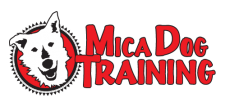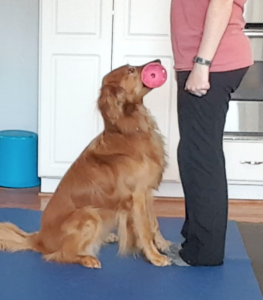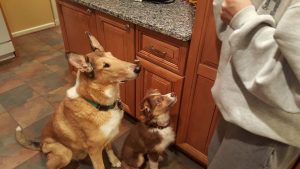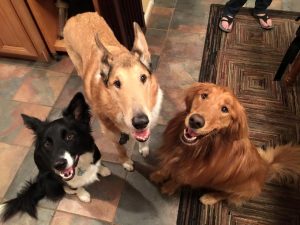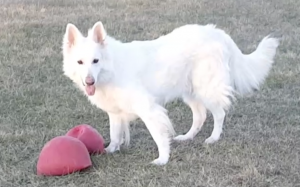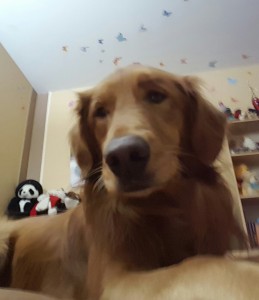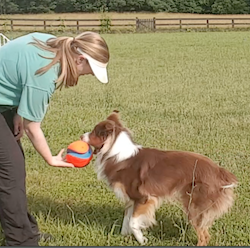
I watched enviously as my friend’s dog retrieved the ball and dropped it into her outstretched hand. My dogs always dropped the ball at least 5 feet away and I had to go pick it up.
I wanted my new dog to actually return the ball to me and place it directly into my hand. Previously, I taught Clover to retrieve a dumbbell to my hand so it seemed like a similar method might work with teaching my puppy Gambit to retrieve a ball to my hand. (Clover’s mostly blind so she can’t retrieve to hand with much distance.)
There was a snag in my plan. Initially, Gambit didn’t want to retrieve at all. Half of the time he didn’t even chase after the ball as it rolled away. The Facebook video of one of Gambit’s littermates taunted me. It showed the puppy retrieving multiple times on the very same day he arrived in his new home. But Gambit was on his own schedule. I had to have faith that eventually he would learn to love retrieving.
First Step: Returning to me with the ball
I worked a lot on throwing the ball and running away, encouraging Gambit to chase me. Sometimes he would run after me and sometimes he wouldn’t. Sometimes he ran after me but dropped the ball. We practiced in small spaces inside and then gradually worked up to playing with 2 balls outside. Shade Whitesel’s toy class through Fenzi Dog Sports Academy was very helpful.
I often played with Gambit without touching the ball when he returned to me. I never took the ball from his mouth and I always traded him for anything he picked up. Separately we worked on an “out” cue, which meant spit out whatever is in your mouth and I will reward you.
Picking up various objects
I also worked on clicker training Gambit to pick up various objects, keys, a fork, chopsticks, etc. We also worked on hand targeting so Gambit was used to coming in close to touch my hand with his nose. And I think the most important skill I taught Gambit, besides running back to me with the ball, was chin targeting.
Chin Targeting
One of the first skills I teach new dogs is chin targeting. I find it to be a super useful behavior. It helps the dog think about targeting with different body parts. I can use chin targeting to teach a dog to hold a dumbbell, move into a stand, side step, find the correct position for front and I’m sure I can come up with several other uses. I also found I could use chin targeting to teach Clover to bring a dumbbell to me and teach Gambit to return his ball to my hand.
Putting it together
For some dogs, you can use a hand touch to get them to come closer with their ball but I wanted the toy or object actually delivered to my hand.
Once Gambit was happily shoving his chin into my hand we then worked on this skill in different locations and from varying distances. We were also separately working on him running back to me with his ball. When Gambit was performing both skills reliably, we started putting chin targeting and retrieving together.
As Gambit moved toward me with his ball I would cue him to put his chin in my hand. With the chin cue my dog is delivering his chin to my hand so it’s easy to add the next step of putting the ball in my hand. I started to say my drop cue – which for Gambit is “out” – when his chin was in my hand and then began to say it a bit earlier, just before he put his chin in my hand, so the ball dropped into my palm. I would then mark the drop with a “yes” and reward him with a ball toss. Eventually I changed the cue to “pick up” so Gambit would know he was picking up an object and delivering it to my hand. Subsequently, I no longer needed to cue chin and then the drop/out separately.
I’m very happy with the results. It is clear to Gambit when he is returning the object to my hand and he understands the reward is that I will throw the ball again or we will work a bit and then I will throw it.
How did you teach your dog to retrieve to your hand?
If you’d like help teaching chin targeting, retrieving, retrieve to hand, or another skill, Mica Dog Training is now offering live online lessons. Work with our trainer in the comfort of your home. Find out more here.
*Some dogs naturally return the ball to your hand if you just put out your hand and some dogs can be easily transitioned from a hand touch to placing the ball in your hand. Utilizing chin targeting with retrieving has worked well with my dogs and several client dogs.
